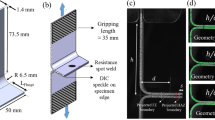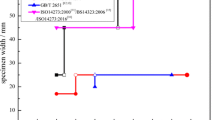Abstract
This paper suggests a very simple, force-based formula that combines four failure modes into one dimensionless equation to govern spot weld failure under general static loading conditions. The four failure modes are shear, rotation, normal and peel. The normal separation mode and the peel mode are corresponding to mode I (opening mode). The tensile/shear mode is mode II (sliding mode), and the in-plane rotation mode is mode III (tearing mode). Test coupons and test fixtures are designed and tested to establish and verify this equation. To further verify this equation, a long difficult to understand automotive spot weld failure problem was studied. Applying finite element-calculated resultant loads to the proposed formula resulted in analytical values that correlated very well with the long time field observed spot weld failures. This analytical prediction reasonably explained the spot weld failure mechanism and provided good design directions to improve the durability of the auto structure.
Similar content being viewed by others
References
Radaj, D., “Structural Stress, Notch Stress and Stress Intensity Approach for Assessment of Fatigue Strength of Spot Welded Joints,” International Institute of Welding Annual Assembly (1989).
McMahon, J.C. andLawrence, F.V., “Fatigue Crack Initiation and Growth in Tensile-shear Spot Weldments,”Fatigue and Fracture Testing Weldments, ASTM STP 1058, American Society for Testing and Materials, Philadelphia, 47–77 (1990).
Swellam, H.M., Kurath, P., andLawrence, F.V., “Electric-potentialdrop Studies of Fatigue Crack Development in Tensile Shear Spot Welds,”ASTM STP 1122, American Society for Testing and Materials, Philadelphia, 383–401 (1991).
Kurath, P. andFatemi, A., “Multiaxial Fatigue Life Predictions under the Influence of Mean Stress,”Trans. ASME, J. Eng. Mat. Tech.,110,380–388 (1988).
Brown, M.M. andMiller, K.J., “Theory for Fatigue under Multiaxial Stress-strain Condition,”Proc. Inst. Mech. Engineers,187,745–755 (1973).
Andreas, R., Klaus, S., and Vatroslav, G., “Computer Aided Dimensioning of Spot Welded Automotive Structures,” SAE Paper No. 950711 (1995).
Kurath, P., “Multiaxial Fatigue Criteria for Spot Welds,” SAE Paper No. 920668 (1992).
Broek, D., Elementary Engineering Fracture Mechanics, Martinus Nijhoff Publisher, 4th rev. ed., Boston (1986).
Wung, P. and Stewart, W., “Method of Analyzing Spot Welded Structures,” U.S. Serial No. 09/347558 patent pending (1999).
Wung, P., Walsh, T., Ourchane, A., and Stewart, W., “The Ignored Failure Mode: Spot Weld under In-plane Rotation (Physical Test),” SAE Paper No. 1999-01-3212 (1999).
Wung, P., Walsh, T., Ourchane, A., Stewart, W., Chow, C.L., andJie, M., “Failure of Spot Weld under In-plane Static Loading,” EXPERIMENTAL MECHANICS,41,100–106 (2001).
Lin, S.H., Pan, J., Wu, S.R., Tyan, T., and Wung, P., “Failure Loads of Spot-welded Joints under Combined Open and Shear Loading Condition,” SAE Paper No. 2001-01-0428 (2001).
Chow, C.L., Jie, M., and Wung, P., “An Analytical Solution for Spotwelded Overlap Sheets,” Internal report, University of Michigan at Dearborn (2000).
Wung, P., “Spot Weld Degradation,” Ford Report No. RVT507-TR00-0021 (2001).
Author information
Authors and Affiliations
Rights and permissions
About this article
Cite this article
Wung, P. A force-based failure criterion for spot weld design. Experimental Mechanics 41, 107–113 (2001). https://doi.org/10.1007/BF02323112
Received:
Revised:
Issue Date:
DOI: https://doi.org/10.1007/BF02323112




